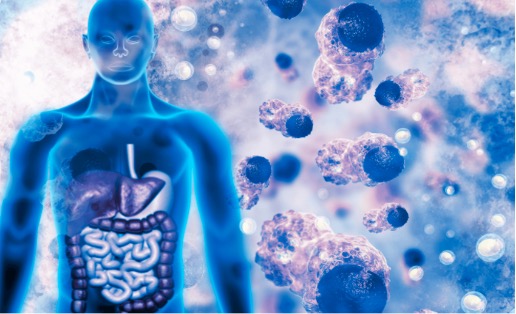Risk factors
It is usually not possible to know exactly why one person develops cancer and another does not. But research has shown that certain risk factors may increase a person's chances of developing cancer. In many cases, cancer is something that develops because of certain lifestyle choices. Of course, smoking or excessively sunning yourself can lead to cancer. So can exposure to certain toxins and just in general an unhealthy lifestyle. However, there are steps you can take to help prevent cancer. This doesn't mean you won't ever get some form of cancer as sometimes you are just predisposed to cancer, but, it means that you are doing all you can to stay healthy.
The common risk factors for cancer that can be prevented can be referred to as Modifiable Risk Factors such as tobacco, sun exposure, radiation exposure, chemicals, and other substances. Whereas there are other causes of cancer that is not preventable (referred to as Non-Modifiable Risk Factors) such as family history or aging.
Modifiable Risk Factors
- Obesity: “More than 1.9 billion adults, aged 18 and above are overweight, with 650 million being obese.” (source: World Health Organisation). People who are obese may have an increased risk of several types of cancer, including breast cancer (in women who have been through menopause), colon, rectum, endometrium (lining of the uterus), esophagus, kidney, pancreas, and gallbladder.
- Physical inactivity: “Approximately 3.2 million deaths occur each year due to insufficient physical activity.” (source: World Health Organisation).
- Moderate to heavy alcohol consumption: “In 2016, more than 3 million deaths are due to harmful use of alcohol, accounting for 1 in every 20 deaths.” (source: World Health Organisation). Drinking alcohol can increase your risk of cancer of the mouth, throat, esophagus, larynx (voice box), liver, and breast. The more you drink, the higher your risk. The risk of cancer is much higher for those who drink alcohol and also use tobacco.
- Long term smoking: “Tobacco kills more than 7 million people worldwide, where over 12.7% of those deaths are among non-smokers who were exposed to secondhand smoke.” (source: World Health Organisation). People who use tobacco products or who are regularly around environmental tobacco smoke (secondhand smoke) have an increased risk of cancer because tobacco products and secondhand smoke have many chemicals that damage DNA. Smoking and Tobacco use causes many types of cancer, including cancer of the lung, larynx (voice box), mouth, esophagus, throat, bladder, kidney, liver, stomach.
- High consumption of processed meat: “Processed meat has been classified as Group 1, carcinogens to human due to sufficient evidence that the agent causes cancer.” (source: World Health Organisation)
- Very low intake of whole-grain fiber, fruit, and vegetables: “Increased consumption of fruits and vegetables could potentially save 2.7 million lives worldwide every year.” (source: World Health Organisation)
- Exposure to radiation, including ultraviolet radiation from the sun. Radiation of certain wavelengths, called ionizing radiation, has enough energy to damage DNA and cause cancer. Ionizing radiation includes radon, x-rays, gamma rays, and other forms of high-energy radiation. The sun, sunlamps, and tanning booths all give off ultraviolet (UV) radiation. Exposure to UV radiation causes early aging of the skin and skin damage that can lead to skin cancer.
- Chronic Inflammation: May be caused by infections that does not go away, abnormal immune reactions to normal tissues, or conditions such as obesity. In chronic inflammation, the inflammatory process may begin even if there is no injury, and it does not end when it should. Over time, chronic inflammation can lead to changes in the affected cells and in nearby immune cells, can cause DNA damage and lead to cancer.
- Infections with some viruses, bacteria, and other germs: Some viruses directly affect the genes inside cells that control their growth. These viruses can insert their own genes into the cell, causing the cell to grow out of control. Other common virus are the Hepatitis B, Hepatitis C virus (HBV and HCV) and Human immunodeficiency virus (HIV) virus. Long-term infection of the stomach with Helicobacter pylori (H pylori) can cause ulcers, as it can damage the inner layer of the stomach. H pylori infection is also linked with some types of lymphoma of the stomach. Human papillomaviruses (HPVs) infection caused nearly all cervical cancers.
Non-Modifiable Risk Factors
- Age: Advancing age is the most important risk factor for cancer overall, and for many individual cancer types. One-quarter of new cancer cases are diagnosed in people aged 65 to 74. A similar pattern is seen for many common cancer types. For example, the median age at diagnosis is 61 years for breast cancer, 68 years for colorectal cancer, 70 years for lung cancer, and 66 years for prostate cancer.
- Personal or family history of colorectal cancer and/or polyps: “About 1 in 4 colorectal cancer patients have a family history of colorectal cancer, suggesting that it could be due to genetic and/or hereditary factor” (Colorectal Cancer Alliance)
- Personal history of chronic inflammatory bowel disease: “Patients with chronic inflammatory bowel disease are said to have an increased risk of developing colorectal cancer and extra-intestinal malignancies as a result of chronic intestinal inflammation” (Axelrad et al., 2016)
- Certain inherited genetic conditions: “Genetic specialists estimate that between 3-10% of a 100 cancer cases are due to inherited faulty genes” (Cancer Research UK)
Common Signs of Cancer: Symptoms You Can't Ignore
Women are usually more diligent than men when it comes to their own health care. But many women ignore symptoms that may be indicative of cancer. If a new health problem arises, do get it checked out soonest possible as the sooner a problem is explained the sooner treatment can be begun. Many forms of cancer can be cured if they are found early.
- Unexplained Weight Loss - could be a symptom of a cancer. Cancer cells often use much of the body's energy supply, which can lead to this weight loss.
- Extreme Tiredness (Fatigue) - may be because cancer cells use up much of the body’s energy supply. Or the cancer could release substances that change the way the body makes energy. It could also be a sign of some cancers such as leukemia or some colon or stomach cancers.
- Unusual Bleeding - Blood in stool may be something benign such as a hemorrhoid, or it may be a sign of colon cancer. Blood in the urine may be mistaken for menstrual blood (for women), but it could be bladder or kidney cancer. Coughing up blood could be symptom of esophagus or lung cancer. An early sign and symptom of endometrial cancer is often spotting between periods. Blood in urine or semen may be a warning sign of prostate cancer for men.
- Persistent Cough - If you have a prolonged cough lasting more than three to four weeks, coupled with shortness of breath, chest pain, wheezing and/or hoarseness but you do not have a cold, allergies, the flu, and, consult your doctor, especially if you smoke. Also take notice if there are any white patches inside the mouth or white spots on the tongue as they may be signs of a precancerous condition called leukoplakia that can lead to oral cancer.
- Gnawing Abdominal Pain and Depression - When depression is coupled with abdominal pain, it may be a symptom of pancreatic cancer.
- Bloating - Signs of ovarian cancer include bloating and other digestive issues, abdominal or pelvic pain, feeling full quickly even if you have not eaten much, and urinary urgency.
- Loss of bladder control or increased frequency of urination – may be a warning sign for prostate cancer in men.
- Unexplained Indigestion - may be a cause of concern as it may be an early sign of cancer of the esophagus, stomach, or throat.
- Difficulty Swallowing - may be a symptom of a gastrointestinal (GI) cancer, such as esophageal cancer.
- Fever and Changes in Lymph Nodes – Fever may be an early sign of some blood cancers such as leukemias and lymphomas. Fever may also occur when a cancer has spread (metastasized) from the original site to other parts of the body. Enlarged lymph nodes or lumps on your lymph nodes under your armpit or in your neck may be a sign of possible cancer. If the lump is increasing in size and has been present for over a month, see a doctor. It may be due to an infection, but it could be a sign of something else such as cancer.
- Pain in the bones of the lower back, hips, and/or ribs - Unexplained pain, especially one that persists and has no known cause may be a sign of cancer.
- Breast Changes - Symptoms of inflammatory breast cancer include redness and thickening of the skin on the breast. A new lump that does not go away for about a month, but instead is slowly enlarging needs to be checked out right away. Other breast changes might include a rash that persists for weeks, changes in the nipple, or discharge when you are not breastfeeding.
- Skin Changes - Moles that are changing, irregular in shape or color, or asymmetrical are common signs of skin cancer. But other skin changes can be signs too, including changes in skin pigmentation, bleeding, or excessive scaling.
How You Can Prevent Cancer from Happening to You
If you do have a family history of cancer, then you probably don't want to do things which raise your chances even higher of getting cancer. Here's what you can do to hopefully prevent it.
- Reduce your sugar intake. It has been proven that cancer develops in an environment that is rich in glucose. Less oxygen and more sugar increases your risk of getting cancer.
- Don't use tobacco products. This goes for smoking or chewing. Tobacco products are linked to many different types of Cancer including lung, bladder, cervix, kidney, oral cavity, and pancreas. Avoid tobacco products at all costs and you'll decrease your risks of developing cancer greatly.
- Exercise regularly. It doesn't really matter what kind of exercise - just keep moving. Exercising regularly and maintaining a healthy die will help in reducing obesity. Getting involved in more physical workouts and making it a point to walk or run for at least 30 minutes every day.
- Eating a Healthy Diet - By making it a point to reduce the consumption of processed food and red meat and to always maintain a balanced diet. Be sure to include plenty of anti-inflammatory foods and those rich in antioxidants in your diet. A balanced diet of natural nutrients, vitamins and mineral supplements will help maintain a healthy body chemistry.
- Watch the consumption of alcohol as much as you can whether by setting a budget when you go out and drinking more water at social events to reduce the thirst for alcohol.
- Drop Those Extra Pounds - Obesity, specified as having a BMI (body mass index) of thirty or higher, increases the chance of developing colorectal cancer. Bringing down your weight-to-height ratio brings down your BMI, which diminishes your risk of acquiring cancer of the colon or rectum. You can't alter your height, so the only affair left is your weight.
- Get enough sleep. Your body needs that time or rest to rejuvenate cells, so make sure you're getting the right amount of sleep. A recent written report shows that acquiring at least 7 hours of sleep every night may maximize cancer prevention advantages in physically active adult females.
- Protect yourself in the sun. Use a sunscreen with an SPF (Sun Protection Factor) of at least 15. Reapply frequently. Cover yourself with clothing. Wear dark colors. Wear a hat. Avoid midday sun. Stay in the shade. Avoid tanning beds and lights.
- Stay up to date on your immunizations. Protecting yourself from certain types of viruses will limit your chances of getting some cancers. Hepatitis B and HPV (Human Papillomavirus) are two vaccines you should be sure you have.
- Maintain a proper pH (potential Hydrogen) in your body. A balanced pH level is more oxygen rich and an environment which cancers do not do well in. To do this, drink a lot of water, eliminate soda, reduce the amount of meat you eat, minimize your consumption of sweets, and eat a lot of raw vegetables.
- Avoid risky behavior which can lead to infections. This means practice safe sex and don't share needles. HIV or AIDS increases a person's chance of getting cancer of the anus, liver, or lungs. HPV like mentioned above is associated with cervical cancer. This is a sexually transmitted disease. Sharing needles increases your chances of Hepatitis B or Hepatitis C.
These ten things are just some ways you can take cancer into your own hands and reduce your risk of getting it. Of course, be pro-active and stay on top of your medical care. Seeing your doctor regularly and screening for cancers will help you diagnose a problem early, possibly preventing it from turning into cancer.
Cancer is a disease that touches on a lot of individuals. Many cancer-causing agents have been discovered by researchers. Most forms of cancer can be prevented by making a few primary life-style alterations, such as exercising and eating healthy, averting sun exposure and refraining from tobacco use.
Preventing cancer, the leading killer worldwide, isn't as easy as popping a pill or getting a vaccination. All the same, according to the World Health Organization (WHO), more than thirty percent of all cancer deaths can be prevented. Tobacco use is the single biggest factor when determining cancer risk. You are able to incorporate all these strategies in your fight against cancer or to prevent it and help prolong your life. Nothing is guaranteed in life, but you will feel much better if you follow these tips.
Learn more how Hi-Bliss Hydrogen Therapy and Hydrogen Water can help improve the Quality of Life of Cancer patients here: https://wordpress-851564-2937612.cloudwaysapps.com/treatment-services-detox-wellness/

References:-
- Anti‑inflammatory and antitumor action of hydrogen via reactive oxygen species (Review) ~ Ye Yang, Yaping Zhu And Xiaowei Xi; ONCOLOGY LETTERS 16. 2018. DOI: 10.3892/ol.2018.9023
- Therapeutic potential of molecular hydrogen in ovarian cancer~ Lei Shang, Fei Xie, Tyler W. Lebaron et.al. TRANSLATIONAL CANCER RESEARCH 2018;7(4):988-995. DOI:10.21037/tcr.2018.07.09
- Protective effect of hydrogen‑rich water on liver function of colorectal cancer patients treated with chemotherapy ~ Qingxi Yang, Guangdong Ji, Rongtao Pan et.al. MOLECULAR AND CLINICAL ONCOLOGY 7: 891-896, 2017. DOI: 10.3892/mco.2017.1409



